For many travelers to Sapa, besides the familiar destinations such as the ancient stone church, Love Market, Ham Rong Mountain, Fansipan Peak… many choose to explore the ethnic villages to learn about their daily life and traditional culture. One of the villages that tourists love when visiting Sapa is Ta Van village. Today, Cuong will introduce you to the things you must try when visiting Ta Van village, such as admiring the terraced fields, staying at a homestay, checking in at the Cloud Bridge… Make sure not to miss any of the things Cuong mentions below when you visit Ta Van.
Where is Ta Van Village in Sapa?
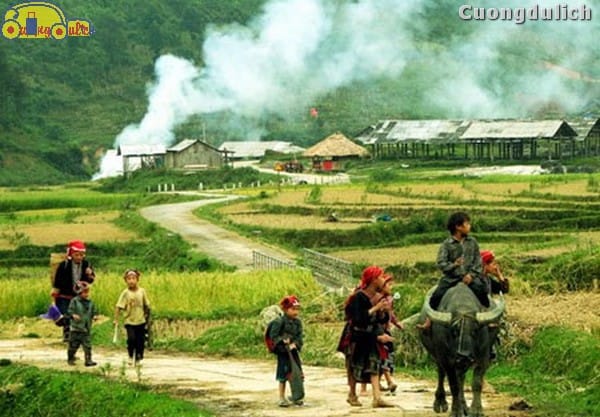
Ta Van village is located in Ta Van commune, Sapa district, Lao Cai province, about 12 km from Sapa town.
In the Mong ethnic language, Ta Van means a large arc, as the village leans against the Hoang Lien Son mountain range and faces the winding Muong Hoa stream.
Ta Van village is the living place of the Mong ethnic people for generations, as well as the Red Dao and Giay ethnic groups. If you want to admire the entire beauty of the Muong Hoa valley, you must visit Ta Van village.
How to get to Ta Van Village in Sapa
Cuong knows that many travelers to Sapa often stay at hotels in the center of Sapa town, then set off to Sapa’s tourist destinations such as Cat Cat village, Muong Hoa valley, Ta Van village. Since it is about 12 km from the center of Sapa town, Cuong often sees tourists hiring motorbike taxis, taxis, or cars to get to Ta Van village.
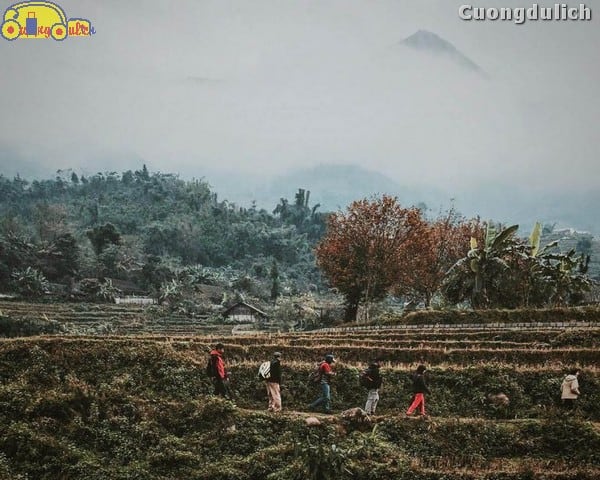
Cuong will guide you the way from the center of Sapa town to Ta Van village, in case any of you want to explore the route on your own. From Sapa town, you move through Cau May street, following the flow of the Muong Hoa stream will lead you to Ta Van village. From Muong Hoa street, you go through the inner city of Sapa until you reach the ticket checkpoint. From this checkpoint, you will be guided on the way to Ta Van village. At the beginning of the village, there is a red iron bridge crossing the Muong Hoa stream leading into Ta Van village. Furthermore, nowadays due to the development of tourism demand, Sapa has exploited many routes, each leading to a different village, so for backpackers or those who like to explore the routes, you can follow the paths leading to different villages.
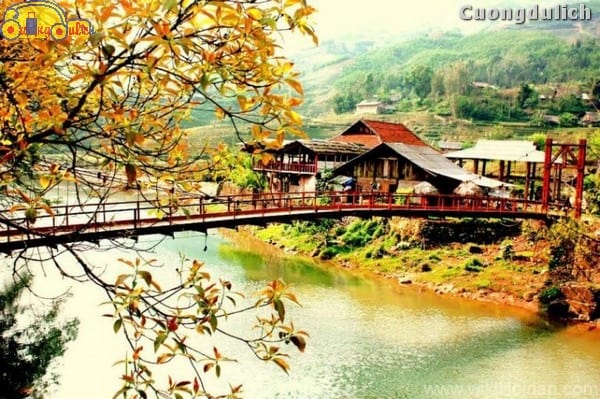
The final way to reach Tả Van village is by trekking, which means walking to Tả Van village. Cuồng sees many Western backpackers using this method. Along the way, Cuồng meets many people walking, enjoying the view of the Muong Hoa valley, and taking lots of selfies. This walking route is a bit challenging, but after overcoming all the difficulties, reaching the destination feels rewarding. The path is now easy to walk on, paved all the way to the village center. You can ask the H’Mong girls going to Sapa market to accompany you back to the village. Cuồng is sure that chatting with these kind-hearted ethnic girls while walking will shorten the distance, and you will learn a lot about their way of life.
Ticket Prices for Visiting Tả Van Village in Sapa
A few years ago, tourists could visit Tả Van village without paying any entrance fee. There was no strict control at the entrance. But now, most tourist spots in Sapa charge an entrance fee, and Tả Van village is no exception. The purpose of charging an entrance fee is to support the livelihood of the villagers. The money from ticket sales is used for repairing and maintaining the road leading to the village.
When Cuồng visited Sapa earlier this year, the ticket price for visiting Tả Van village was 75,000 VND per adult. However, the ticket booth is not always strictly monitored, so on days with bad weather or around noon, there may be no one checking tickets, allowing you to visit for free. Many people taking a taxi to the village also do not get their tickets checked! Alternatively, you can tell the ticket inspectors that you are visiting the homes of Mr. A, B, C in Tả Van village, and they will let you in without any hassle.
5 Experiences You Must Try When Visiting Tả Van Village in Sapa
Admire the Ripened Rice Terraces
When talking about the outstanding scenery of Tả Van village, it would be a huge oversight to ignore the rice terraces. These terraced fields, crafted by the hard work of generations of ethnic people, wind around the hills and mountains, stretching as far as the eye can see, seemingly blending into the horizon. The terraced fields, along with the majestic mountains, lush greenery, create a magnificent natural landscape. Standing here, amidst the vast land and sky, breathing in the pristine air of the mountainous region, you will feel the same as Cuồng, as if transported to a place untouched by industrialization, free from the hustle and bustle of urban life. If you want to escape for a few days, “leave everything behind and go,” to slow down, to reconnect with your true self, then Tả Van village in Sapa is a destination you must visit, Cuồng believes so.
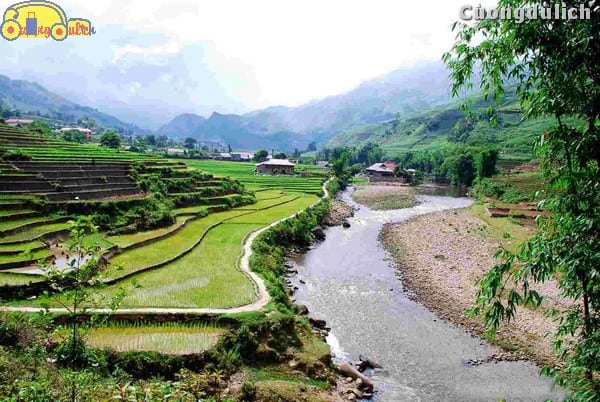
You can visit the terraced fields in Ta Van village in any season of the year and still capture some unforgettable check-in photos. In the village during the rice transplanting season, you will see the terraced fields like giant silver mirrors, reflecting the majestic mountains and forests. In the summer, the terraced fields are covered with lush green rice paddies. Autumn brings the golden harvest season, attracting many tourists to Ta Van to admire the shimmering golden rice fields, promising a bountiful season. In the evening, watching the children herding buffaloes back home creates a familiar scene of rural Vietnam that Cuong hasn’t seen in a long time. If you visit Ta Van in the spring, you will see traditional houses mixed with the fresh pink of cherry blossoms and the white of plum and apricot blossoms. The sky in Ta Van with dust rain and fog creates a dreamy atmosphere, making you feel like you’re in a dreamland rather than reality. In winter, Ta Van covered in white snow gives you the feeling of being in a pure, pristine paradise, without any impurities.
Check out the stunning homestays in Ta Van Sapa
Perhaps a one-day visit to Ta Van is not enough, you need to stay a few days to explore all the interesting places Cuong mentioned above and to learn about the local people’s way of life. Therefore, Cuong will introduce you to some amazing homestays in Ta Van.
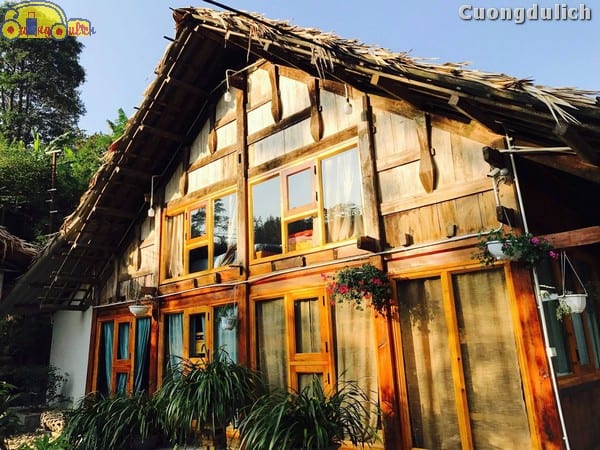
Similar to Cat Cat village, Tavan village now has many homestays to serve the needs of both domestic and international tourists. Wherever you go, you can find places to rent accommodation with a variety of homestays or overnight stays. It can be said that homestays are popping up like mushrooms. So, you no longer have to rush back to Sapa town before dark, nor worry about not having a place to stay in the village. In Tavan village, there are now beautiful homestays with full amenities such as bedding for a good night’s sleep. And the prices are extremely affordable, starting from only 50,000 – 100,000 VND per night, much cheaper than in other famous tourist areas, right?
If you are traveling to Sapa during peak season, you can call ahead to book a homestay in Tavan village, but Cuong thinks this is not really necessary. There are plenty of homestays in Tavan village for you to choose from, so no need to worry about not finding a place to stay.
If you ask Cuong if there are hotels in Tavan village, Cuong will tell you that Tavan village is the home of ethnic minorities, so there are currently no hotels or guesthouses. The only form of accommodation in Tavan village at the moment is homestays. But in fact, Cuong likes this type of accommodation because you get to stay with locals, participate in their daily activities, and learn about their way of life. Many homestays have clear price signs displayed at the entrance, so you don’t have to worry about bargaining. The ethnic people are kind and genuine like that.
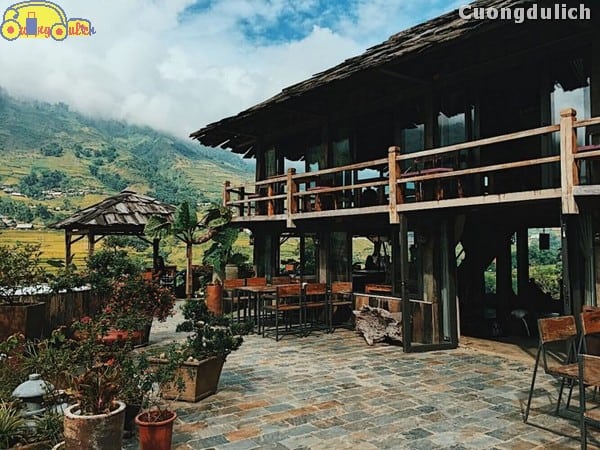
Cuong sees many travelers choosing homestays in the Ta Van village, particularly in the Ta Van Giay area at the foot of the mountain with over 110 houses of the Giay ethnic people. The reason is quite understandable, as staying here allows visitors to enjoy panoramic views of the terraced fields and the nearby Muong Hoa stream. Currently, many families in Ta Van Giay have been granted licenses to operate homestay services, so you can rest assured about the quality and facilities. Most of the visitors are foreigners from countries like Sweden, Norway, France, the United States, and Australia, so if you want to make friends with Westerners, this is the area to choose a homestay!
Some of the popular homestays nowadays, frequented by many hot girls checking in on Facebook, in Ta Van village include places like Ta Van Go Homestay, Ta Van Hill Homestay, Ta Van Family Homestay, and La Dao Homestay…
See more:
Checkin Cầu Mây ở bản Tả Van
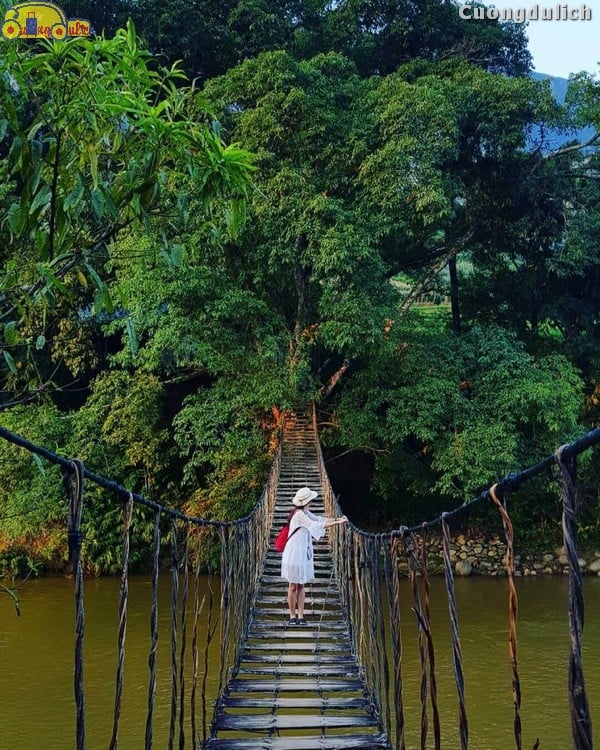
The bridge that once caused a frenzy on social media and even gained fame internationally is the Cloud Bridge in Ta Van village. Since ancient times, the villagers have been creating bridges to cross streams and rivers to facilitate transportation. These bridges are made of forest ropes and thin wooden planks, hence the name Cloud Bridge. Nowadays, most of the bridges crossing streams leading to the village have been replaced with iron bridges for safety reasons. Therefore, the rare Cloud Bridge in Ta Van village attracts tourists who come to admire and take countless breathtaking photos. However, this bridge has been around for a long time and can be quite difficult to walk on, so you need to be careful when walking in the middle of the bridge to take photos, especially during the rainy season when the thin wooden planks can become slippery. Nevertheless, the feeling of crossing a hanging bridge over a stream is quite adventurous and worth trying, especially for young people.
So why does Cuong say that the Cloud Bridge in Ta Van is famous worldwide? It’s all thanks to a photo taken by American photographer Skip Nall of the Cloud Bridge in Ta Van during a trip to Sapa with a friend. The photo of the Cloud Bridge hanging in the misty weather was displayed in stores of the Swedish furniture company IKEA and caught the attention of many travel enthusiasts around the world. After admiring the photo of the Cloud Bridge, many tourists did not hesitate to travel long distances to Vietnam and Sapa, specifically to Ta Van village, to see this bridge with their own eyes.
Taste the specialty Thang Co of Muong Khuong Sapa
Thang Co is a popular dish among the ethnic groups in the Northwest region, especially in the highland markets. Originally made from horse meat, other ethnic groups have added beef, buffalo, and pork to create various versions of this dish with different ingredients and cooking methods. However, the most delicious Thang Co is still the horse meat Thang Co in Bac Ha, Muong Khuong, Sapa – Lao Cai, the homeland of this unique Sapa specialty.
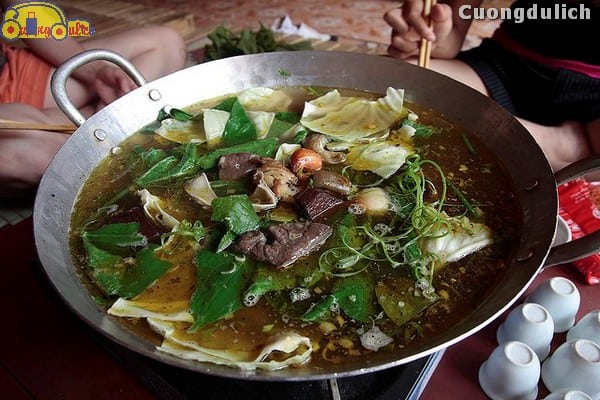
A traditional pot of horse meat stew includes horse meat, intestines, heart, liver, horse blood… and 12 types of herbs and spices such as cinnamon, star anise, lemongrass, ginger, and many other traditional spices. Among them, cinnamon is the 12th spice. The dish is quite simple to prepare. The horse meat and organs are cleaned, marinated with traditional spices. Then, in a large pan, all the meat and organs are stir-fried until the meat is slightly seared, then water is added to the pan and simmered vigorously for hours on a glowing charcoal stove. Parts like heart, liver, intestines, meat, bones are added last and simmered, sometimes with added vegetables.
When eating, the broth is scooped into a hotpot, sliced horse meat is added. The accompanying vegetables include water spinach, water celery, cabbage… The dipping sauce is made from a special chili sauce in Mường Khương that is salty, spicy, and pungent, providing warmth when eaten. The cleaned horse organs have a very fragrant taste, crispy and delicious. The distinctive taste of horse meat, tender and sweet, blends perfectly with the dipping sauce.
Explore the Tả Van Gíay village
The Tả Van Gíay village still preserves many original customs of the indigenous people more than other villages in Tả Van. Tả Van Gíay is the oldest village in Tả Van, located in the Hoàng Liên National Park. Many Western backpackers are willing to trek deep into the remote villages of Tả Van to explore. You can find your way to the Seo Mý Tỉ village, located 14 km from the center of Tả Van commune, where there is a very large and beautiful lake, still maintaining its pristine beauty as it is less known to the public.
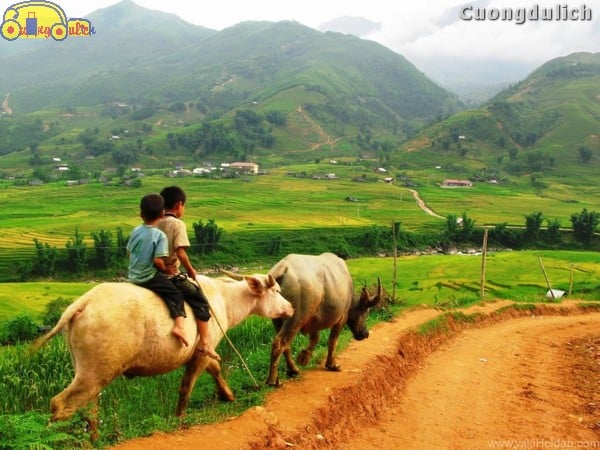
The main job of the Giay people is growing rice, so if you want, you can learn about how to grow rice on terraced fields, see if it’s different from the rice cultivation culture of the Kinh people. In addition, the people of Ta Van Giay village also have the profession of making silver jewelry, crafting handmade tools that require skilled and meticulous hands of artisans.
Visiting Ta Van Giay village in Sapa, you will admire the beautiful natural painting of the Northwest mountainous forest region. You will immerse yourself in the sound of murmuring streams, melodious bird songs, and explore the simple and rustic beauty of the village scenery here.
So Cuong has listed for you the 5 must-try experiences when visiting Ta Van Sapa. Anyone who visits Ta Van and hasn’t done these things can be considered as not having truly visited. For students, you can join Sapa tours on your own to save costs, or you can choose all-inclusive Sapa tours like 2 days 1 night Sapa tour to ensure a complete and convenient exploration of all Sapa tourist spots!
